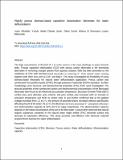| dc.contributor.author | Elisadiki, Joyce | |
| dc.contributor.author | Jande, Yusufu | |
| dc.contributor.author | Kibona, Talam | |
| dc.contributor.author | Machunda, Revocatus | |
| dc.date.accessioned | 2020-11-04T11:37:36Z | |
| dc.date.available | 2020-11-04T11:37:36Z | |
| dc.date.issued | 2019-12-09 | |
| dc.identifier.uri | https://doi.org/10.1007/s11581-019-03372-z | |
| dc.identifier.uri | https://dspace.nm-aist.ac.tz/handle/20.500.12479/999 | |
| dc.description | This research article published by Springer Nature Switzerland AG., 2019 | en_US |
| dc.description.abstract | The high concentration of fluoride (F−) in water sources is the main challenge in major fluoride belts. Though capacitive deionization (CDI) with porous carbon electrodes is the promising alternative in removing charged species from aqueous solution, little has been presented on the usefulness of CDI with biomass-based electrodes in removing F− from natural water existing together with other ions such as Ca2+ and Mg2+. This study investigated the feasibility of using biomass-based electrodes for natural water defluoridation application. Porous carbon was synthesized from jackfruit peels (JFAC) through potassium hydroxide (KOH) activation. Surface morphology, pore structure, and electrochemical properties of the JFAC were investigated. The textural properties of the synthesized carbon and electrochemical characteristics of the fabricated electrodes were found to be influenced by activation temperature. Brunauer-Emmett-Teller (BET) surface area, pore diameter, pore volume, and pore surface area increased with an increase in activation temperature and KOH to carbon ratio. It was further confirmed that as the applied voltage increased from 1.2 to 2 V, the amount of adsorbed anions increased without significantly affecting the pH of the water. At 2.0 V, the electrodes showed a maximum F− adsorption efficiency and electrosorption capacity of 62% and 0.13 mg/g respectively. The electrosorption capacity depends on the initial concentration of the ion in the feed water. It was further observed that natural organic substances contained in the natural water might inhibit JFAC electrode surface and decrease its adsorption efficiency. This study provides cost-effective CDI electrode material prepared from biomass for water defluoridation. | en_US |
| dc.language.iso | en | en_US |
| dc.publisher | Springer Nature Switzerland AG. | en_US |
| dc.subject | Capacitive deionization (CDI) | en_US |
| dc.subject | Water defluoridation | en_US |
| dc.subject | Electrosorption capacity | en_US |
| dc.subject | Porous carbon | en_US |
| dc.title | Highly porous biomass-based capacitive deionization electrodes for water defluoridation | en_US |
| dc.type | Article | en_US |

